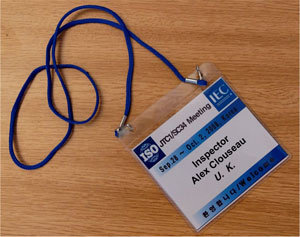Nothing of interplanetary significance to report, I’m glad to report steady progress on all fronts.
As many of you already know, standards maintenance consists of two main activities:
- Defect removal through the issuance of corrections to published standards (variously called “errata” or “corrigenda”, depending on your zodiacal sign)
- Revision, through the issuance of updated (and presumably improved) versions of the standard.
The OASIS ODF TC has been active in both maintenance activities, with some notable milestones in the past week or so on both fronts.
On the maintenance side, Wednesday 29 October saw the start of a 15-day public review for draft 3 of the ODF 1.0 Errata document. The official OASIS announcement has more information on the public review, including links to the errata document itself, as well as how the public may submit comments. JTC1/SC34, though their Secretariat, has also been invited to participate in this review.
Once the public review has concluded, and assuming that no new issues surface in the review, the ODF TC may approved and publish it as “OASIS Approved Errata” as well as transmit the text to JTC1/SC34 for application to ISO/IEC 26300.
On the revision front, the TC continues to work to complete ODF 1.2. But while finishing that revision, we decided that we also want to initiate a new activity related to the next version of ODF, the one after ODF 1.2. We did not have immediate agreement on what that version would be called (ODF 1.3? ODF 2.0?) so we started calling it “ODF-Next”. We voted to create a new Subcommittee of the ODF TC, called the ODF-Next Subcommittee to start preliminary background work on this next version, in parallel with the TC’s foreground task of completing ODF 1.2. The charter of the new subcommittee reads:
Statement of purpose
——————–
As the ODF TC completes its work on ODF 1.2, it is desirable to instantiate a parallel effort to gather requirements and define a vision for the next major revision of the standard.It is the purpose of the ODF-Next Requirements Subcommittee to gather requirements, to categorize these requirements by theme, to prioritize these requirements, and to submit a report to the ODF TC on a recommended set of work items for the next major version of ODF, which will have the working name of “ODF-Next”.
Scope of work
————-
In accordance with the above Purpose, the ODF-Next Requirements SC would undertake the following activities:To collect requirements for ODF-Next from TC members, from the OASIS ODF Adoption TC, from implementors, from users, from the public, and from other stakeholders;
To ensure that all requirements collected have been formally submitted as contributions to the ODF TC, either as TC member contributions or via the Feedback License;
To categorize these comments according theme;
To prioritize the themes and the requirements within the themes;
To produce and submit to the ODF TC a report on a recommended set of work items for ODF-Next
Bob Jolliffe, from the Department of Science and Technology, South Africa, has agreed to chair the Subcommittee. We had our first meeting last Tuesday.
I think this is going to be exciting. ODF 1.0 and ODF 1.1 was about mainly about encoding, in an open standard, the output of conventional productivity applications. If you are a conventional person, running a convention business, with conventional ideas looking for a conventional profit, then great, don’t let me wake you up. But I think we need to do more than that. Achieving mere conventional doesn’t get me out of bed in the morning. If I wanted to just replicate what others were doing, I’d join the Mono project.
ODF 1.2 starts to break away from that conventional view with its richer view of metadata. But with ODF-Next, we can pull significantly ahead and move into uncharted territory. As Thomas Paine wrote, “We have it in our power to begin the world over again.”
As you can tell, from reading the charter, our primary initial task will be to collect feedback for feature ideas for the next release of ODF. When we formally put out the call for comments, I expect a huge response. So our initial TC meeting was mainly spent discussing ways in which we can can handle a large volume of public comments, in terms of collection, categorizing and prioritizing. Once we agree on a tool to use, and set up some infrastructure to handle the load, expect to hear more on this blog, and elsewhere, about how you can submit your ideas, and help define the capabilities of the next version of ODF.
Next, I’d like to note that the OASIS ODF Interoperability and Conformance TC (OIC TC) met for the first time last week (and a second time again this week). We elected Bart Hanssens of Belgium as Chair of the technical committee. Bart works for Fedict, the Belgian federal ICT agency, one of the early adopters of ODF. Companies represented on the TC include IBM, Sun, Novell, Google, Oracle, Red Hat, Sursen, Ars Aperta, and the US Department of Defense. We also have a number of individual members.
The greatest difficulty in our initial call was determining a schedule for future meetings. With participants spread out from California to Boston, Paris, Hamburg and Beijing, there is no time which is going to be easy for all of us. The best we could come up with was to meet at 1430UTC, corresponding to 0930 EST, 1530 CET, 2230 China, but 0630 PST (ouch).
In any case, the OIC TC discussions are flowing well, as we start to discuss how we engineer test cases, what data to collect for them, how to encode test metadata, etc. You can follow the discussion in the public archives of the TC’s mailing list, or even better, consider joining OASIS ($300 for an individual membership) and participate in this or any other OASIS Technical Committee.
Finally, the ODF Adoption TC has been busily preparing to host a panel discussion and workshop related to ODF interoperability at the OpenOffice.org Conference in Beijing next week. In fact, I should now stop procrastinating and get back to completing by presentations!
If you add it all up: the three ODF-related TC’s (ODF TC, ODF Adoption TC, ODF Interop and Compliance TC), we have a combined 79 members, of which 68 represent 25 different OASIS corporate or organizational entities, and the remaining 11 are individual members.
-Rob



